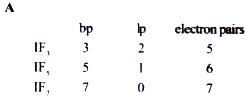The number of pairs of electrons around I in IF3,IF5 and IF7, respectively, areSolution in Malayalam
5, 6 and 7
5, 7 and 6
7, 5 and 6
7, 6 and 5
The correct Answer is:A
Topper's Solved these Questions
- CHEMICAL BONDINGBOOK - BRILLIANT PUBLICATIONCHAPTER - CHEMICAL BONDINGEXERCISE - LEVEL-II
100 Videos
- CHEMICAL BONDINGBOOK - BRILLIANT PUBLICATIONCHAPTER - CHEMICAL BONDINGEXERCISE - LEVEL-II (ASSERTION-REASON TYPE)
20 Videos
- CHEMICAL BONDINGBOOK - BRILLIANT PUBLICATIONCHAPTER - CHEMICAL BONDINGEXERCISE - LEVEL-III ( Linked Comprehension Type )
12 Videos
- CHEMICAL AND IONIC EQUILIBRIUMBOOK - BRILLIANT PUBLICATIONCHAPTER - CHEMICAL AND IONIC EQUILIBRIUMEXERCISE - Level - III (Linked Comprehension Type Questions)
1 Video
- CHEMICAL BONDING AND MOLECULAR STRUCTUREBOOK - BRILLIANT PUBLICATIONCHAPTER - CHEMICAL BONDING AND MOLECULAR STRUCTUREEXERCISE - QUESTION (LEVEL -ll)
42 Videos
Similar Questions
Polarising action of Cd2+ on anions is stronger than that of Ca2+ because
View SolutionIn the following question, an Assertion (A) is followed by a corresponding Reason (R). Use the following keys to choose the appropriate answer.
Assertion : In case of (CH3)3N geometry is pyramidal, but in case of (SiH3)3N it is planar.
Reason : The maximum covalency of Si is six but that of C is four. : If both (A) and (R) are correct and (R) is the correct explanation of (A)., If both (A) and (R) are correct, but (R) is not the correct explanation of (A)., If (A) is correct, but (R) is incorrect., If both (A) and (R) are incorrect.
View SolutionIn an ionic bond, the cation tends to polarize the electron cloud of the anion by pulling electron dens towards itself. This causes development of covalent character in the ionic bond because the electron dens gets localised in-between the nuclei. The tendency of the cation to bring about the polarization of the anion expressed as its polarizing power. The ability of ion to undergo polarization is called its polarisability. The polarising power of a cation or an anion is decided on the basis of Fajans' rules.
The ionic conductance of which of the following is the highest?
View SolutionThe degre of dissociation of weak electrolyte is inversely proportional to the same square root of concentration. What is called Ostwald's dilution law.
α=√Kac As the temperature increases, degree of dissociation will increase.
α1α2=√Ka1Ka2 if concentration is same. α1α2=√c2c1 if acid is sam.
For two monobasic acids HA1 and HA2 at the same concentration α1 and α2 are in ratio of 1:2. Ka1=2×10−4. What will be Ka2 ? 8×10−4, 2×10−4, 4×10−4, 1×10−4
View SolutionWhich of the following species are hypervalent ?
(l) ClO−4
(ll) BF3
(lll) SO2−4
(lV) CO2−3
View SolutionStatemet : IF7 is super-ociet molecule .
Explanation : central atom of I in IF7 has 14 electrons .
View SolutionShape and hybridization of IF5, respectively, are
View SolutionWhich of the following interhalogens exist at room temperature and have central atom hybridization sp3d2.
(a) ClF3 (b) ClF5 (C) BrCl3 (d) IF3 (e) IF5 (f) BrF5 (g) IF7 (h) ICl5 (I) lBr5(j) BrF3 (k) ClBr5
View SolutionNumber of electrons around I in IF_(7) is
View SolutionIn IF_3 . Hybrid state of iodine is sp^3 d . There are two lone pair and three bondpairs of electron. Lone pair electorn is positioned on :
View SolutionIF5 की आकृति तथा संकरण क्रमशः है।
View SolutionThe oxidation number of iodine in IF5 is :
View SolutionOxidation number of iodine in IF_3 is:
View SolutionGive oxidation state and number of lone pair of electron in IF_7
View SolutionThe shape of IF5 and IF7 are respectively
View Solution
